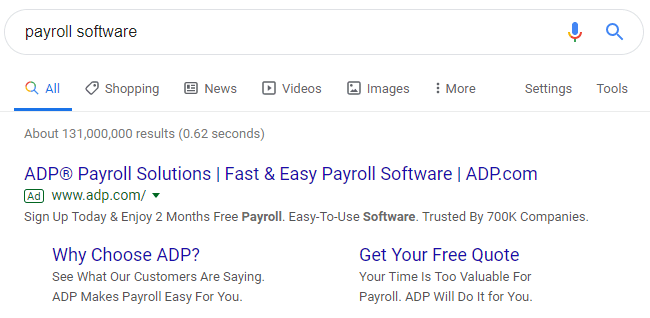
This post was co-written by Holly Niemiec and Conor Bond.
You need to develop a lot of different skills if you want your online advertising campaigns to achieve their full potential. Even if you’ve created watertight keyword lists and razor-sharp lookalike audiences, something still stands between your prospects and your business: ad copy.
A beaut. Value prop, social proof, sitelinks—we’re getting ahead of ourselves.
At the end of the day, you need people to click on your ads—awareness campaigns on YouTube and the GDN notwithstanding. To be more precise, you need the right people to click on your ads. In order to make that happen, you need to elevate your copywriting game.
Check out our eight best copywriting tips for Google and Facebook!
4 copywriting tips for Google Ads
For the sake of clarity, we’ll start by focusing solely on your search campaigns. Here are our four best tips for writing irresistible Google ads.
1. Align your messaging with the customer journey
Google strives to serve users the most relevant search results possible. When judging the relevance of the various ads competing in a given auction, Google relies on keywords. In a nutshell, keywords help Google determine which ads are relevant to a particular query. That’s why it’s considered best practice to target specific keywords with your ad copy.
Now—I’m not about to argue that you shouldn’t include target keywords in your ad copy. However, I am of the opinion that keywords shouldn’t be your main focus when writing ads. Instead, you should be focused on meeting the unique needs of whoever’s searching for something related to your business—and that means aligning your messaging with the various stages of the customer journey.
Here’s what I mean by that. Across the pool of search queries triggering your ads, the users making those searches are at different stages in the customer journey—the path people take from the realization of a problem to the purchase of a solution. Whereas someone at the very beginning of their customer journey—known as the awareness stage—is mostly interested in learning more about the options they can choose from, someone nearing the end of their customer journey—known as the conversion stage—is far more likely to make a purchase.
TripAdvisor’s ad is perfect for someone at the beginning of their customer journey.
When evaluating the search results and deciding which one to click, users are guided by whatever it is they need to accomplish at that moment in time. Therefore, enticing users to click on your ads requires writing ads that help them do what they need to do. Often, this commitment to aligning your copy with the stages of the customer journey means being a bit more relaxed about keyword targeting. And that’s okay.
Think of it this way: Nobody clicks on an ad because they’re impressed by its keyword density. Instead, they click on an ad because it makes a compelling offer.
💰 Ready to hit the jackpot of ad copywriting tips? Download the free guide: >> 10 Tricks to Get the Click: How to Write Exceptional PPC Ad Copy
2. Tell people why they shouldn’t click on your ad
Wait—what? Aren’t we here to talk about writing ads that entice people to click? Why the heck would I tell people to not click on my ads?
Because sometimes your ads will be triggered by people who are more likely to forge a friendship between Matt Barnes and Derek Fisher than become your customer. It seems absurdly obvious, but it warrants boldface text: You don’t want users to click on your ads unless there’s a chance they’ll eventually become your customers. Otherwise, you’re spending money on clicks that offer nothing in return. That’s … less than ideal.
In a perfect world, there’d be a surefire way to completely eliminate any chance of attracting unqualified clicks. Although, sadly, that’s not the case, there are copywriting strategies you can use to reduce the risk of those budget-draining clicks taking place. The most straightforward way to do this is using your copy to tell users who your product or service is for—thus communicating who it’s not for at the same time.
If you’re not a student, you wouldn’t click this ad, would you?
For example, let’s say your company sells specialty skin care products for women. In order to drive high-funnel website traffic and fill your remarketing pool, you’re bidding on the modified broad match keyword +skin +care +products. There’s a problem, of course: the ads you’ve tied to this keyword can easily be triggered by male users. Because your products are exclusively for women, you don’t want men clicking on your ads. So, what do you do? Simple—you include the phrase “for women” in your ads’ headlines and descriptions. Although this tactic won’t eliminate all clicks from male users, it will certainly reduce them.
3. Don’t waste space on what users already know
Although text ads have continued to expand over the years, you’re still limited in the number of characters you can use. Considering you have a finite amount of space to make your company stand out from your competitors on the SERP, wasting precious characters on information users already have is one of the worst things you can do as a copywriter. As an example of what not to do, check out this ad I saw when I searched “crm software”:
If this ad were included in a branded search campaign, I wouldn’t really have any issues with it. Alas, this isn’t the case—”crm software” is a high-funnel query. If you ask me, the intent behind the query is pretty clear: I’m in the market for a CRM software solution and I’m using Google to find out what my options are. Let’s be frank with our friends over at Pipedrive: There’s absolutely no reason to click on that ad. Why? Because the headline doesn’t tell me anything I didn’t already know. More to the point, it doesn’t tell me anything about the value Pipedrive delivers to their customers.
By contrast, check out this ad from Zoho—which was served higher on the SERP for the exact same search query:
Though I’m typically fond of minimalism—it’s one of the reasons I’ll never stop going back to 808s & Heartbreak—I’ll admit that this description could be a lot better. But let’s focus on the headline for now. More specifically, let’s focus on the second part of the headline: Close more deals every day. That’s a beaut of a value proposition if I’ve ever seen one, and it’s the main reason Zoho’s ad is infinitely more clickable than Pipedrive’s.
4. Optimize your copy for smaller devices
Imagine, if you will, a nightmare scenario. You’ve just finished writing the perfect text ad—one that matches the intent behind the keyword it’s targeting, cleverly dissuades unqualified users from clicking, and dedicates part of the headline to making a clear value proposition.
But once it’s been live for a couple weeks, you notice that it’s performing really poorly on mobile. What happened? One explanation: Google’s been reducing your copy to optimize for smartphones—and the best parts of your ad aren’t making the cut.
I’ll explain. About a year ago, Google made text ads even bigger by giving advertisers a third 30-character headline and a second 90-character description. As exciting as it is to get 120 extra characters to play with, there’s a catch: Smaller devices, such as smartphones and mini tablets, can’t always accommodate three headlines and two descriptions. In those cases, Google will automatically cut some of your copy. To avoid having the most important parts of your ads removed—which could both increase unqualified clicks and decrease qualified clicks—make sure to include this information in your first two headlines and your first description.
Here’s a great example of an ad that’s prepared to lose its third headline on mobile devices. Although it’s ideal to include your company’s brand name in your headline, it’s certainly not essential. What is essential is communicating value to your prospects. Because they’ve placed their value proposition at the beginning of this ad’s headline, the folks over at Nutshell don’t need to worry about losing a substantial amount of click volume on mobile devices.
4 copywriting tips for Facebook Ads
Although Google has certainly stepped up their audience targeting game over the past few years, Facebook is still the platform to use when setting your sights on specific groups of people. As powerful as that is, getting your messaging in front of the right prospects is only half the battle; the messaging itself is still extremely important. Here are four of our best tips for writing the best Facebook ads you possibly can.
1. Test, test, test
Being a digital marketer—or a business owner who moonlights as a digital marketer—means making assumptions. When we advertise in the Google search results, we assume that the keywords we’re targeting reflect the level of intent we’re looking for. When we create a Facebook custom audience, we assume that the users we’re going after will be interested in our offer. And when we write ad copy, we assume that it will resonate with our prospects.
We hate to break it to you, but that’s not necessarily the case. Sometimes, the Facebook ad copy you’ve agonized over will miss the mark—as indicated by a low click-through rate (failure to entice the right users) or a low conversion rate (failure to ward off the wrong users).
Although you can’t get around making assumptions, you can turn those assumptions into valuable learning experiences. That’s why it’s crucial to run A/B tests.
An A/B test, quite simply, is an exercise that compares the performance of two ads. Although you can use this strategy to optimize a range of Facebook advertising assets—your target audience, your call to action, etc.—A/B testing works especially well when refining your ad copy. Ultimately, you want to answer a single question: Does a particular style of messaging resonate with our audience significantly better than another style of messaging?
Here’s a simple example. You’re just getting started with Facebook advertising and you want to find out which tone—casual or professional—your target audience prefers. For one week, you could target that audience with a casual-sounding ad. The next week, you could target the same users with a professional-sounding ad. If one version performs significantly better than the other, you’ve got yourself an actionable copywriting insight!
2. Do your best to blend in
Unfortunately, we’re going to be the bearers of bad news once again: Generally speaking, people don’t like being advertised to—especially when they’re just trying to post some photos or check in on their friends’ status updates. In fact, Facebook has taken this into account with their ad auction algorithm. The less engagement Facebook expects your ad to get—that is, the less Facebook expects your target audience to like your ad—the worse you’ll perform.
Does this mean you should give up altogether? Of course not—Facebook advertising works really well. What it does mean is that you need to write ads that create a good experience for the users you’re targeting—and that means blending in with your surroundings.
Believe it or not, writing Facebook ads that don’t disrupt the user experience is simpler than it sounds. All you have to do is think carefully about what your target audience wants to see. Remember what we said earlier about writing Google Ads copy that matches your prospects’ stages in the customer journey? You can use that same basic philosophy to create effective, relevant Facebook ads that blend seamlessly into your prospects’ News Feeds.
Let’s use another example. You’ve been advertising on Facebook for a little while now and you’re eager to introduce your business to a new crop of users. So you create a lookalike audience based on the people who’ve clicked on your ads in the past. Taking into account that this is the first time these users will be engaging with your business, asking them to sign up for a free trial of your product is a surefire way to not blend in; that ad would stick out like a sore thumb. Alternatively, asking them to check out a video or a blog post is totally appropriate—so appropriate that some users may initially realize that it’s an ad! That’s a winner.
3. Don’t shy away from long copy
We know, we know—we’re contradicting best practices yet again. According to the conventional wisdom, social media ad copy should always be brief.
Sometimes? Of course—brief copy has its place. Always? We’re not convinced.
As far as we’re concerned, there are three key things you need to think about when writing Facebook ad copy: the content you’re pushing, the action you want users to take, and the level of familiarity between your business and those users.
If, for example, you’re using Facebook Ads to promote a new webinar that you want users to register for, it makes sense to write a little extra copy and give those users a substantial idea of what they’ll be getting. Generally, people aren’t eager to submit their personal information through an online form when they’re not sure what they’ll get in return.
Additionally, writing extra copy to provide a sneak preview is an excellent way to dissuade unqualified users. Assuming you want to minimize the number of bad leads you generate, it makes sense to actively scare off anyone who doesn’t want to become your customer.
Finally, extending your ad copy can be an effective tactic when you’re trying to reach users who’ve never interacted with your business before. If you tell a cold audience that you’ve just launched your summer clothing campaign, that’s not going to mean much to them. Alternatively, if you use some extra copy to give a high-level overview of the value your business can offer, that can make a big difference with those new prospects.
4. Think about who’s seeing your ad
Though Google and Microsoft (which owns Bing) have substantially stepped up their audience targeting game over the years, Facebook still reigns supreme as the advertising solution that enables you to target robust, carefully segmented audiences. Despite an ongoing (and necessary) effort to trim down the number of targeting parameters advertisers have at their disposal, Facebook still gives you some really powerful stuff to work with.
Case in point: You have the power to target Facebook users who have birthdays around the corner. By using your ad copy to make those users feel special, you can drive a lot of sales in a short period of time.
Make no mistake—just because your first touchpoint with a user was based on an event that only comes around once a year, doesn’t mean you have to wait another 364 days to re-engage them. Let’s say you target men with anniversaries coming up to drive ticket sales for an upcoming concert. Once the concert has passed, you can retarget those dudes with some really personalized ad copy. Something along the lines of “The special day has passed, but there’s still plenty of music to enjoy” could make a really big impact.
The bottom line: Thanks to the audience targeting capabilities Facebook affords you, you can be incredibly precise and personal with your ad copy.

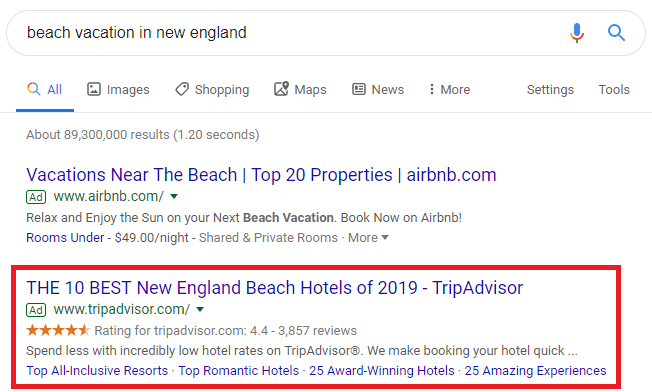




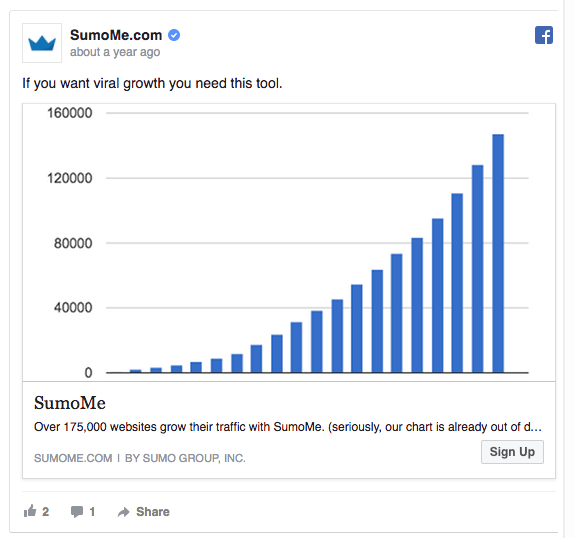
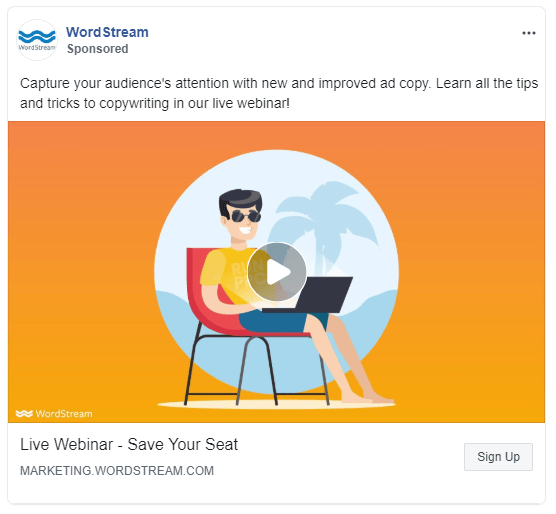
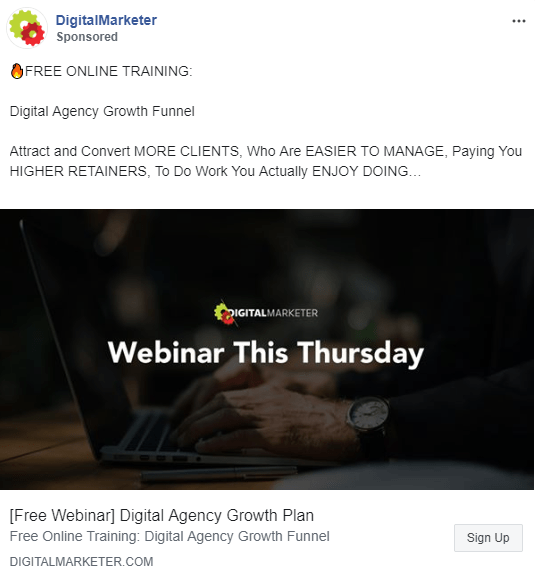
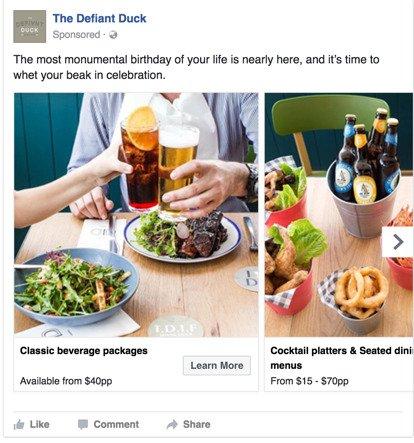
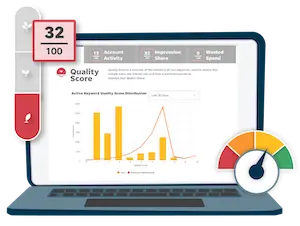







Comments
Please read our Comment Policy before commenting.